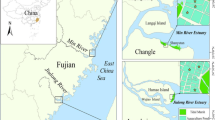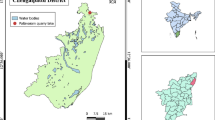Abstract
Anaerobic decomposition of aquatic macrophytes in the sediment of wetlands is a key source of methane to the atmosphere. An experiment was conducted in order to evaluate the potential methane production (PMP) in the sediment colonized by three species of aquatic macrophytes and in the limnetic region of a tropical coastal lagoon. The incubations were prepared and maintained (70 days) at 25.0 °C, and the PMP was measured by gas chromatography. The initial concentrations of dissolved organic carbon (DOC), carbohydrates and methane in the sediment were also measured. The sediment colonized by emergent aquatic macrophytes showed higher PMP due to the higher amounts of carbohydrates. On the other hand, PMP was lower in the limnetic region, which showed lower amounts of carbohydrates. The carbon found in the limnetic region is mainly originated from the refractory detritus of aquatic macrophytes that reaches the central region of the lagoon, with lower carbohydrate content. These results indicate that detritus quality, which means highest concentration of carbohydrates in the DOC, was the main controlling factor of methanogenesis.





Similar content being viewed by others
References
Ambühl H, Bührer H (1975) Zur Technik der Entnahme ungestörter Grossproben von Seesediment: ein verbessertes Bohrlot. Schweizerische Zeitschrift für Hydrologie 37:175–186
Bartlett KB, Harriss RC (1993) Review and assessment of methane emissions from wetlands. Chemosphere 26:261–320
Bastviken D, Cole J, Pace M, Tranvik L (2004) Methane emissions from lakes: dependence of lake characteristics, two regional assessments, and a global estimate. Global Biogeochemical Cycles 18:GB4009
Bédard C, Knowles R (1991) Hypolimnetic O2 consumtion, denitrification, and methanogenesis in a thermally stratified lake. Canadian Journal of Fisheries and Aquatic Sciences 48:1048–1054
Bhullar GS, Iravani M, Edwards PJ, Venterink HO (2013) Methane transport and emissions from soil as affected by water table and vascular plants. BMC Ecology 13:32
Bhullar GS, Edwards PJ, Venterink HO (2014) Influence of different plant species on methane emissions from soil in a restored Swiss wetland. PLoS ONE 9:e89588
Bianchini I Jr, Cunha-Santino MB (2008) As rotas de mineralização do carbono dos detritos de macrófitas aquáticas. Oecologia Brasiliensis 12:20–29
Bianchini I Jr, Cunha-Santino MB (2016) CH4 and CO2 from decomposition of Salvinia auriculata Aublet, a macrophyte with high invasive potential. Wetlands 36:557–564
Bianchini I Jr, Peret AM, Cunha-Santino MB (2006) A mesocosm study of aerobic mineralization of seven aquatic macrophytes. Aquatic Botany 85:163–167
Bousquet P, Ciais P, Miller JB, Dlugokencky EJ, Hauglustaine DA, Prigent C, Van der Werf GR, Peylin P, Brunke E-G, Carouge C, Langenfelds RL, Lathière J, Papa F, Ramonet M, Schmidt M, Steele LP, Tyler SC, White J (2006) Contribution of anthropogenic and natural sources to atmospheric methane variability. Nature 443:439–443
Brehmer P, Chi TD, Laugier T, Galgani F, Laloë F, Darnaude AM, Fiandrino A, Mouillot D (2011) Field investigations and multi-indicators for shallow water lagoon management: perspective for societal benefit. Aquatic Conservation 21:728–742
Bridgham SD, Cadillo-Quiroz H, Keller JK, Zhuang Q (2013) Methane emissions from wetlands: biogeochemical, microbial, and modeling perspectives from local to global scales. Global Change Biology 19:1325–1346
Caliman A, Carneiro LS, Santangelo JM, Guariento RD, Pires AP, Suhett AL, Quesado LB, Siqueira VS, Fonte ES, Lopes PM, Sanches LF, Azevedo FD, Marinho CC, Bozelli RL, Esteves FA, Farjalla VF (2010) Temporal coherence among tropical coastal lagoons: a search for patterns and mechanisms. Brazilian Journal of Biology 70:803–814
Casper P, Chan OC, Furtado ALS, Adams DD (2003) Methane in an acidic bog lake: the influence of peat in the catchment on the biogeochemistry of methane. Aquatic Sciences 65:36–46
Christian RR, Mazzilli S (2007) Defining the coast and sentinel ecosystems for coastal observations of global change. Hydrobiologia 577:55–70
Conrad R (1989) Control of methane production in terrestrial ecosystems. In: Andreae MO, Schimel DS (eds) Exchange of trace gases between terrestrial ecosystems and the atmosphere. Wiley, New York, pp 39–58
Corbett JE, Tfaily MM, Burdige DJ, Cooper WT, Glaser PH, Chanton JP (2013) Partitioning pathways of CO2 production in peatlands with stable carbon isotopes. Biogeochemistry 114:327–340
Costantini ML, Rossi L, Fazi S, Rossi D (2009) Detritus accumulation and decomposition in a coastal lake (Acquatina–southern Italy). Aquatic Conservation 19:566–574
Crozier CR, Delaune RD (1996) Methane production by soils from different Louisiana marsh vegetation types. Wetlands 16:121–126
Dettling MD, Yavitt JB, Zinder SH (2006) Control of organic carbon mineralization by alternative electron acceptors in four peatlands, Central New York State, USA. Wetlands 26:917–927
Dorodnikov M, Knorr K-H, Kuzyakov Y, Wilmking M (2011) Plant-mediated CH4 transport and contribution of photosynthates to methanogenesis at a boreal mire: a 14C pulse-labeling study. Biogeosciences 8:2365–2375
Enríquez S, Duarte CM, Sand-Jensen K (1993) Patterns in decomposition rates among photosynthetic organisms: the importance of detritus C:N:P content. Oecologia 94:457–471
Esteves FA (2011) Fundamentos de Limnologia, 3rd edn. Interciência, Rio de Janeiro
Faria BM, Esteves FA (2001) Dissolved organic carbon in two Brazilian coastal lagoons: sources and utilization for heterotrophic bacteria. In: Faria BM, Farjalla VF, Esteves FA (eds) Aquatic microbial ecology in Brazil, Series Oecologia Brasiliensis IX. PPGE-UFRJ, Rio de Janeiro, pp 57–64
Farjalla VF, Marinho CC, Esteves FA (1999) The uptake of oxygen in the initial stages of decomposition of aquatic macrophytes and detritus from terrestrial vegetation in a tropical coastal lagoon. Acta Limnologica Brasiliensia 11:185–193
Ferrara-Guerrero MJ, Castellanos-Páez ME, Garza-Mouriño G (2007) Variation of a benthic heterotrophic bacteria community with different respiratory metabolisms in Coyuca de Benítez coastal lagoon (Guerrero, Mexico). Revista de Biología Tropical 55:157–169
Fonseca ALS, Minello M, Marinho CC, Esteves FA (2004) Methane concentration in water column and in pore water of a coastal lagoon (Cabiúnas Lagoon, Macaé, RJ, Brazil). Brazilian Archives of Biology and Technology 47:301–308
Fonseca ALS, Marinho CC, Esteves FA (2015) Aquatic macrophytes detritus quality and sulfate availability shape the methane production pattern in a dystrophic coastal lagoon. American Journal of Plant Sciences 6:1675–1684
Geurts JJM, Smolders AJP, Banach AM, van de Graaf JPM, Roelofs JGM et al (2010) The interaction between decomposition, net N and P mineralization and their mobilization to the surface water in fens. Water Research 44:3487–3495
Golterman HL, Clymo RS, Ohnstad MAM (1978) Methods of physical and chemical analysis of freshwaters. Blackwell, Oxford
Joabsson A, Christensen TR (2001) Methane emissions from wetlands and their relationship with vascular plants: an Arctic example. Global Change Biology 7:919–932
Kiene RP (1991) Production and consumption of methane in aquatic systems. In: Rogers JE, Whitman WB (eds) Microbial production and comsumption of greenhouse gases: methane, nitrogen oxides and halomethanes. American Society for Microbiology, Washington, DC, pp 111–146
King GM (1994) Associations of methanotrophs with the roots and rhizomes of aquatic vegetation. Applied and Environmental Microbiology 60:3220–3227
King GM, Roslev P, Skovgaard H (1990) Distribution and rate of methane oxidation in sediments of the Florida Everglades. Applied and Environmental Microbiology 56:2902–2911
Kuivila KM, Murray JW, Devol AH, Lidstrom ME, Reimers CE (1988) Methane cycling in the sediments of Lake Washington. Limnology and Oceanography 33:571–581
Laanbroek HJ (2010) Methane emission from natural wetlands: interplay between emergent macrophytes and soil microbial processes. A mini-review. Annals of Botany 105:141–153
Li X, Cui B, Yang Q, Tian H, Lan Y, Wang T, Han Z (2012) Detritus quality controls macrophyte decomposition under different nutrient concentrations in a eutrophic shallow lake, North China. PLoS ONE 7:e42042
Mach V, Blaser MB, Claus P, Chaudhary PP, Rulík M (2015) Methane production potentials, pathways, and communities of methanogens in vertical sediment profiles of river Sitka. Frontiers in Microbiology 6:506
Marinho CC, Fonseca ALS, Minello M, Esteves FA (2004) Resultados e perspectivas sobre o estudo do metano nas lagoas costeiras da Restinga de Jurubatiba e na Lagoa Imboassica na Região Norte do Estado do Rio de Janeiro. In: Rocha CFD, Esteves FA, Scarano FR (orgs) Pesquisas de longa duração na Restinga de Jurubatiba: Ecologia. História Natural e Conservação. RiMa, São Carlos, pp 273–294
Marinho CC, Meirelles-Pereira F, Gripp AR, Guimarães CC, Esteves FA, Bozelli RL (2010) Aquatic macrophytes drive sediment stoichiometry and the suspended particulate organic carbon composition of a tropical coastal lagoon. Acta Limnologica Brasiliensia 22:208–217
Mattson MD, Likens GE (1990) Air pressure and methane fluxes. Nature 347:718–719
Megonigal JP, Whalen SC, Tissue DT, Bovard BD, Albert DB, Allen AS (1999) A plant-soil-atmosphere microcosm for tracing radiocarbon from photosynthesis through methanogenesis. Soil Science Society of American Journal 63:665–671
Panosso RF, Attayde JL, Muehe D (1998) Morfometria das lagoas Imboassica, Cabiúnas, Comprida e Carapebus: implicações para seu funcionamento e manejo. In: Esteves FA (ed) Ecologia das lagoas costeiras do Parque Nacional da Restinga de Jurubatiba e do Município de Macaé (RJ). NUPEM/UFRJ, Rio de Janeiro, pp 91–105
Petruzzella A, Marinho CC, Sanches LF, Minello M, Esteves FA (2013) Magnitude and variability of methane production and concentration in tropical coastal lagoons sediments. Acta Limnologica Brasiliensia 25:341–351
Reddy KR, DeLaune RD (2008) Biogeochemistry of wetlands: science and applications. CRC Press, Boca Raton
Reiche M, Gleixner G, Küsel K (2010) Effect of peat quality on microbial greenhouse gas formation in an acidic fen. Biogeosciences 7:187–198
Rejmánková E, Houdková K (2006) Wetland plant decomposition under different nutrient conditions: what is more important, litter quality or site quality? Biogeochemistry 80:245–262
Rejmánková E, Sirová D (2007) Wetland macrophyte decomposition under different nutrient conditions: relationships between decomposition rate, enzyme activities and microbial biomass. Soil Biology and Biochemistry 39:526–538
Roland F (1998) Produção fitoplanctônica em diferentes classes de tamanho nas lagoas Imboassica e Cabiúnas. In: Esteves FA (ed) Ecologia das lagoas costeiras do Parque Nacional da Restinga de Jurubatiba e do Município de Macaé (RJ). NUPEM/UFRJ, Rio de Janeiro, pp 159–175
Whiting GJ, Chanton JP (1993) Primary production control of methane emission from wetlands. Nature 364:794–795
Zak D, Reuter H, Augustin J, Shatwell T, Barth M, Gelbrecht J, McInnes RJ (2015) Changes of the CO2 and CH4 production potential of rewetted fens in the perspective of temporal vegetation shifts. Biogeosciences 12:2455–2468
Zinder SH (1993) Physiological ecology of methanogens. In: Ferry JG (ed) Methanogenesis: Ecology, Physiology, Biochemistry & Genetics. Springer Science+Business Media, Dordrecht, pp 128–206
Zink K-G, Furtado ALS, Casper P, Schwark L (2004) Organic matter composition in the sediment of three brazilian coastal lagoons District of Macaé, Rio de Janeiro (Brazil). Anais da Academia Brasileira de Ciências 76:29–47
Acknowledgements
We would like to thank the Coordenação de Aperfeiçoamento de Pessoal de Nível Superior (CAPES) and Conselho Nacional de Desenvolvimento Científico e Tecnológico (CNPq) for financial support. We also thank the two anonymous reviewers for their careful reading of our manuscript and their many insightful comments and suggestions.
Author information
Authors and Affiliations
Corresponding author
Rights and permissions
About this article
Cite this article
dos Santos Fonseca, A.L., Marinho, C.C. & de Assis Esteves, F. Potential Methane Production Associated with Aquatic Macrophytes Detritus in a Tropical Coastal Lagoon. Wetlands 37, 763–771 (2017). https://doi.org/10.1007/s13157-017-0912-6
Received:
Accepted:
Published:
Issue Date:
DOI: https://doi.org/10.1007/s13157-017-0912-6




